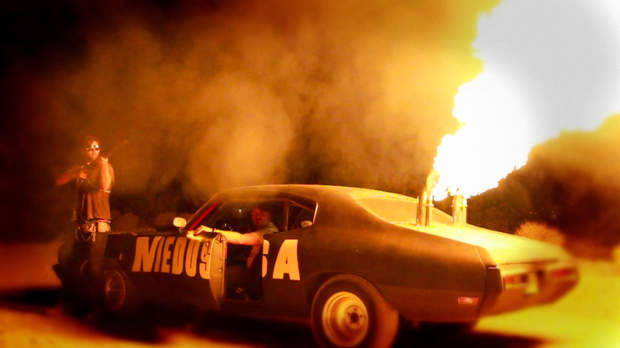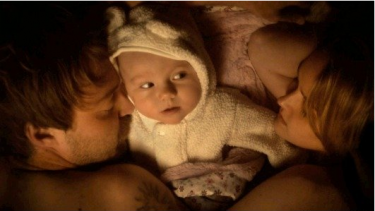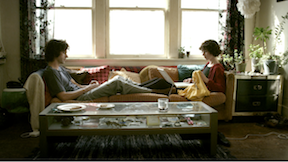 Back to selection
Back to selection
35 Is The New 25, 40 Is Basically 50: The Next Gen Crisis Of Indie Film

To grow up or not to grow up? Three days into Sundance, three very different films have asked this same question.
Bellflower, The Future and The Lie are all, nominally, about the same thing: white people in Los Angeles, unsure of their relationship, trying to reconcile their adulthood with their self-image. Surely these topics – who am I? who should I be with? — are not new to cinema, but their prevalence in the films here at Sundance and in recent American indies can sometimes overwhelm. Last year’s The Freebie, for instance, followed a Los Angeles couple on a journey to self-discovery through infidelity. Happythankyoumoreplease was set in New York (though made by an LA-based actor/director) and chronicled a group of twenty or thirty-somethings trying to love themselves enough to grow up. There are dozens more which cover this same territory, not to mention the oeuvre of Judd Apatow and the last five years of studio rom-coms. In all these films, characters fret over whether they should start acting as old as they are, or whether they might be special enough inside to transcend their ‘just fine’ life. Is this really the defining crisis of a generation of filmmakers – the desire to be great instead of good?

The Lie presents this predicament without irony, adapting a T.C. Boyle story about a couple whose new baby has put the final nail in the coffin of mutual domestication. The husband (played by director Josh Leonard) is afflicted with a growing ennui; we see his dreams of being a musician die in his hands when he finally writes one song and finds out that he is a terrible at music. He begins skipping work to record and smoke pot with his hippie friend, and when his boss confronts him, he blurts out the lie that his newborn daughter has died. He has a gorgeous, cool wife; an adorable daughter; enough money to live in Los Angeles and have modest dinner parties and go camping once in a while. But he’s looking for an excuse to wake up from this dream, seeking out someone to blame for the fact that he is, in fact, the most obvious possible person he could have turned out to be. There were no surprises; his inner specialness shines through to no one but his wife, and even she doesn’t seem that impressed anymore. Stop this endless march into my boring adult self, could read his thought bubble. I am a creative person with a very bright future.
Bellflower crashes into its anti-bourgeois fantasy of living hard, fast, loose and free; it is the life that the characters in The Lie (at least the male ones) dreamt of in their deepest teenage fantasies. A lot of the film pertains to flame throwers, tricked out flame-throwing cars, knifes into orifices, involuntary face tattoos, more flame throwers, eating live crickets, driving motorcycles without helmets, being punched very hard in the face and revenge on cheaters by throwing flames. None of the film pertains to how this group of white twenty-somethings earn money to have their own houses, or what they plan to do when drinking whiskey and throwing flames gets old. They live in Oxnard, not Silverlake, and reportedly moved to California because they “thought it would be cool, like in the movies.” Whereas the characters in The Lie escape their bourgeoise reality by smoking medical marijuana, almost-considering an affair and eventually moving to Portland to work for a non-profit, the population of Bellflower can drive to Texas to eat at the world’s most disgusting restaurant on a first date, in a car that is rigged to dispense whiskey, and as they fall in love, they can trade the car for a handmade motorcycle, and then when they break up, he can spend a week in the hospital recovering from a massive head injury, and they do it all without once mentioning vacation days or health insurance. In The Lie, signifiers like organic diapers, good wine and Volvos decorate the walls of what we are led to believe is really just a well-appointed middle class jail. Real life is too easy to be tolerated in The Lie; Bellflower avoids this topic by refusing to establish its characters in real life at all.
Miranda July’s The Future also features a couple falling apart over issues of self-image and coming together again after experiencing other people. Its couple (July and Hamish Linklater) are 35, she a dancer working as a dance teacher, he a writer working as a tech support operator. They live in a studio-style apartment somewhere in LA, with thrift store furniture and colored paper on the windows. They have decided to adopt a dying cat, and it is the cat who narrates the film, counting down the minutes until his new owners will come for him and prevent his certain death. Sophie and Jason realize that with their cat will come new responsibility, do the math and realize that they have just this one pre-cat month to finally realize all of their latent creative potential. Thirty days until they’re essentially dead. “40 is basically 50… the rest is just loose change,” says Jason; not enough time to really do anything. Jason unplugs his tech support phone and begins selling trees door to door, though he is quickly diverted by an eccentric old man and begins spending days at his house. Sophie unplugs their internet to avoid endless comparative studies of other women dancing on Youtube and vows to make 30 original dances in 30 days. But she quickly realizes that she can’t even accomplish one. At the very moment of complete creative failure, Sophie initiates an affair with an older man whose very square life is swaddled in beige furniture and 1000-thread count sheets. The comparably Stepford-ish existence represents a suburban escape from the pressure of carving your own path out of life as a creative, independent individual.

Does that pressure deserve deep examination, or is the world’s most trite dilemma, worthy merely of scorn and ridicule? Ironically, that question is at the heart of the dilemma itself. All the films and fiction about slow, creeping disappointment in the person you imagined you’d be (and imagined you’d be with) come with the self-conscious awareness that having the time to wonder about whether your life is useless is what makes it useless in the first place.
Let’s define the circumference of the navel at which we’re gazing (turn of phrase hat tip: James Ponsoldt.) Most Sundance films are directed by members of an extremely small urban artistic class seeking respect within their own tiny community. The reach of these films only occasionally spreads beyond the walls of the New York and Los Angeles neighborhoods where their makers reside. They are a concentrated example of a whole swath of American youth experiencing periods of extended adolescence — choosing careers late, marrying late, buying property late. Like some bizarre capitalist mutation on red diaper babies, these young people are encouraged since birth to find their inner specialness and sing their special song to the world. The fact that the world does not, in fact, want to hear their song, and worse yet, that they have no special song to sing, sends them reeling into a whirlpool of thwarted narcissism. It is, to be sure, the bubbliest of champagne problems.
But independent film is at its most powerful when it tells the most specific possible story in the most profound possible way. ‘Who am I and What Am I Doing?’ is not a trite question in the right hands, and it’s not exclusive to well-off hipsters. This is where a film like The Future soars. The climax of Sophie’s story is a dance inside a giant, stretchy yellow t-shirt, which has been crawling towards her (literally crawling across the street, and finally into her 1000-thread-count bedroom window) since she left Jason behind. Jason, meanwhile, has been talking with the moon, as his pain upon hearing of Sophie’s infidelity has somehow allowed him to stop time, and the moon is the only one left awake. Using genuine cinematic inventiveness and original narrative ideas, July’s film adds up to the same thing as all good art: it means nothing, and it means everything.
